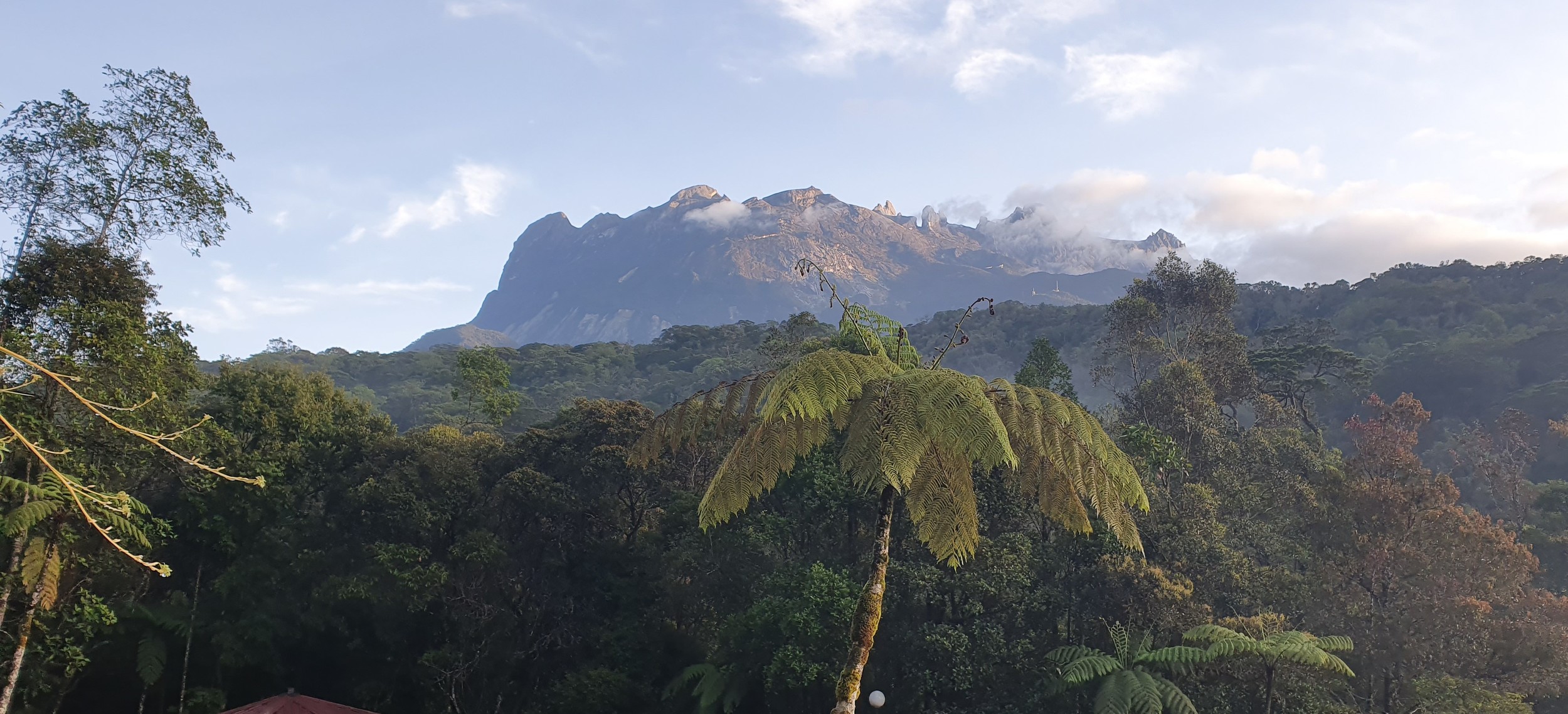Part 2: The adventure bit (continued from the wildlife bit)…
18-19 November
We added the walk to the top of Mt Kinabalu to our itinerary rather late in the planning. I mentioned it vaguely to Erica one evening and she was much keener than I expected. At 4095m Mt Kinabalu is the highest mountain in Borneo and 20th highest in the world by prominence – basically height above the surrounding land. A steep walking trail leads from the edge of the national park to the peak, making it possible to “climb” the mountain without being a mountaineer or having any special gear, though this standard tourist route has to be pre-booked and done with a licensed guide. The journey to the peak and back takes two days, with day one a walk from the Timpohon Gate at 1866m to Laban Rata lodge part-way up the mountain at 3270m, followed by a pre-dawn start the next day for the final 2km walk to enjoy sunrise from the top, before a descent back to the base for early afternoon.
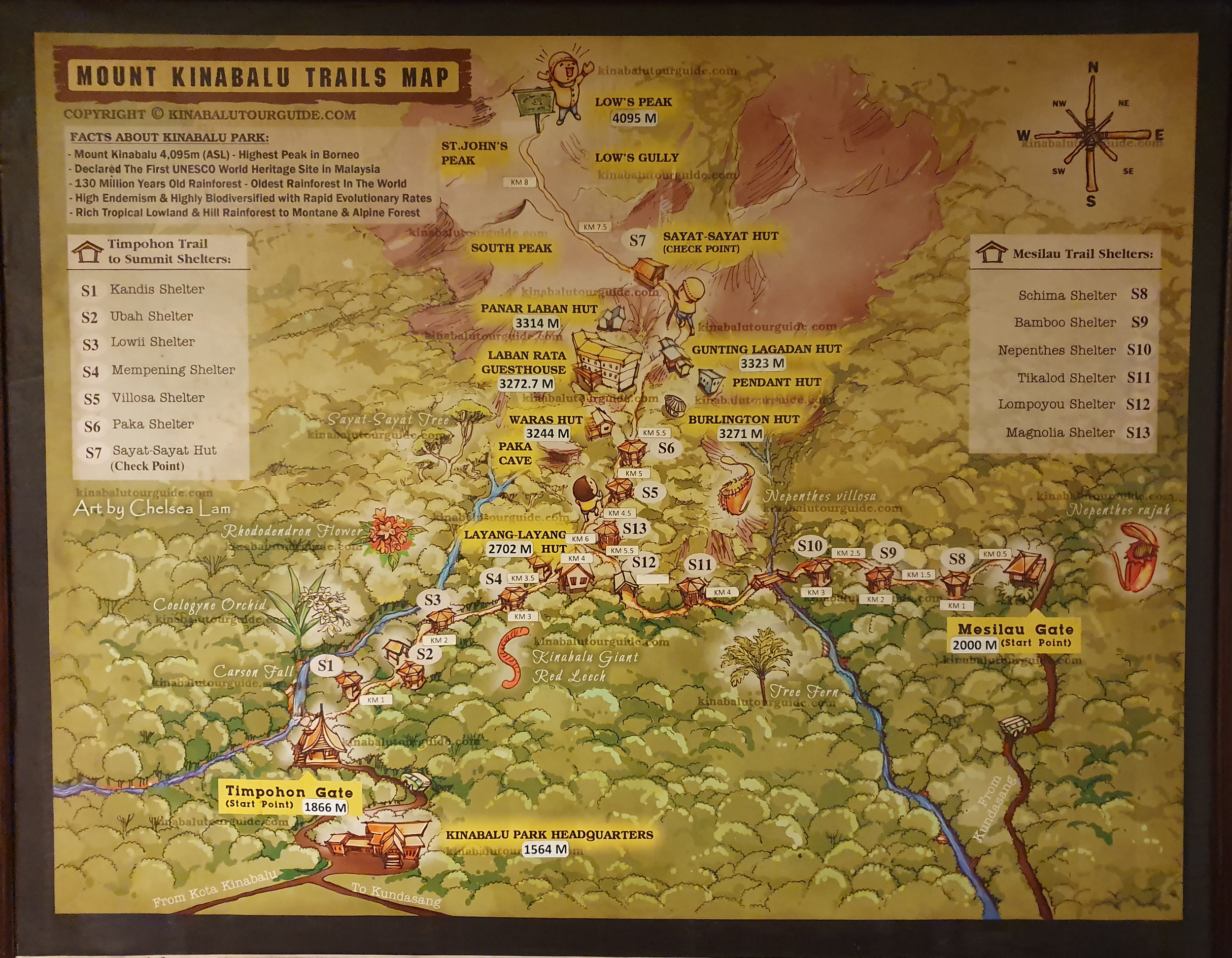
The entire area is surrounded by national park, a UNESCO World Heritage site, dripping in amazing wildlife, including numerous species endemic to the mountain itself (half of all plants above 900m are found nowhere else!). The birding on the mountain is outstanding, with numerous potential lifers for me including “Whitehead’s Trio”, a classic target for trips here with a Trogon, Broadbill and Spiderhunter – named after the 10th century British explorer and collector John Whitehead – all endemic to Kinabalu. But birders generally do not climb the mountain, instead birding the trails around the National Park headquarters. I made a reluctant decision that if we were going to climb the mountain it would be at the expense of birding; I left bins and camera in the car, partly to save weight and partly to ensure I stayed good to my resolution.[1]
We woke, nervous and excited, to a stunning clear morning with views from our comfortable room across to the mountain. It looked amazing and daunting in equal measure!
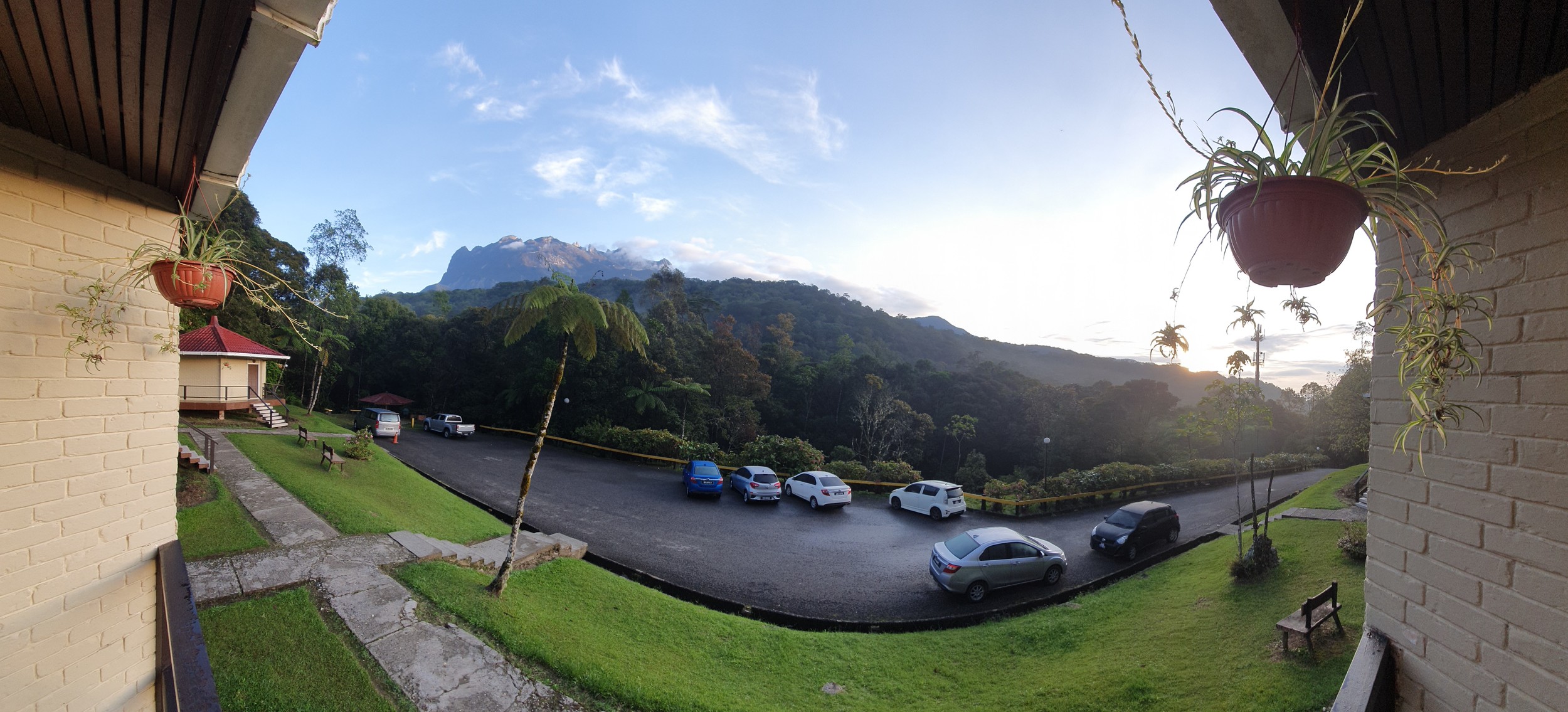
We made our way down from the room to the main park office where we had to register for the walk and meet our guide, Rony, and after some time we went with him in a minibus about 5km to the Timpohon Gate, where our walk would officially start at about 8.30am


The walk ascends from 1800m through tropical rainforest. Though at times I wondered what amazing birds I was missing, most of the time I was admiring the view, concentrating on my footing and looking out for Erica.
The total elevation gain over the two days is 2200m, which I worked out is around 4 lots of our local hill, Mt Lofty. When Eri and I thought about it this way did not seem so bad; after all, Lofty takes about an hour and half to ascend 500m over 4km. Strenuous, yes, but not too bad. Of course I had not considered four additional factors which contribute to making the climb up Kinabalu much harder than 4x Lofty. First was the gradient, not 1-in-8 like Lofty, but more like 1-in-6 for day one and 1-in-4 (or even steeper) for day 2, including some sections across bare granite where you pull yourself up the slope with a rope. Second was the climate. You begin the walk in tropical rainforest where it is hot and sticky. It stays damp but gets gradually colder, and it is rare to complete the walk without some rain along the way. Third is time of day; to get to the peak for dawn (and to allow sufficient tie to get all the way back down on day 2), you start walking at 2.30am, by torchlight. Finally, and perhaps the most significant is altitude. We had come directly from sea level, and though both Eri and I were spared the worst of altitude sickness (unlike some other poor bastards who spent day 2 prone in the lodge, unable to move any further), the thin air leaves you short of breath and having to move much more slowly than you would otherwise.
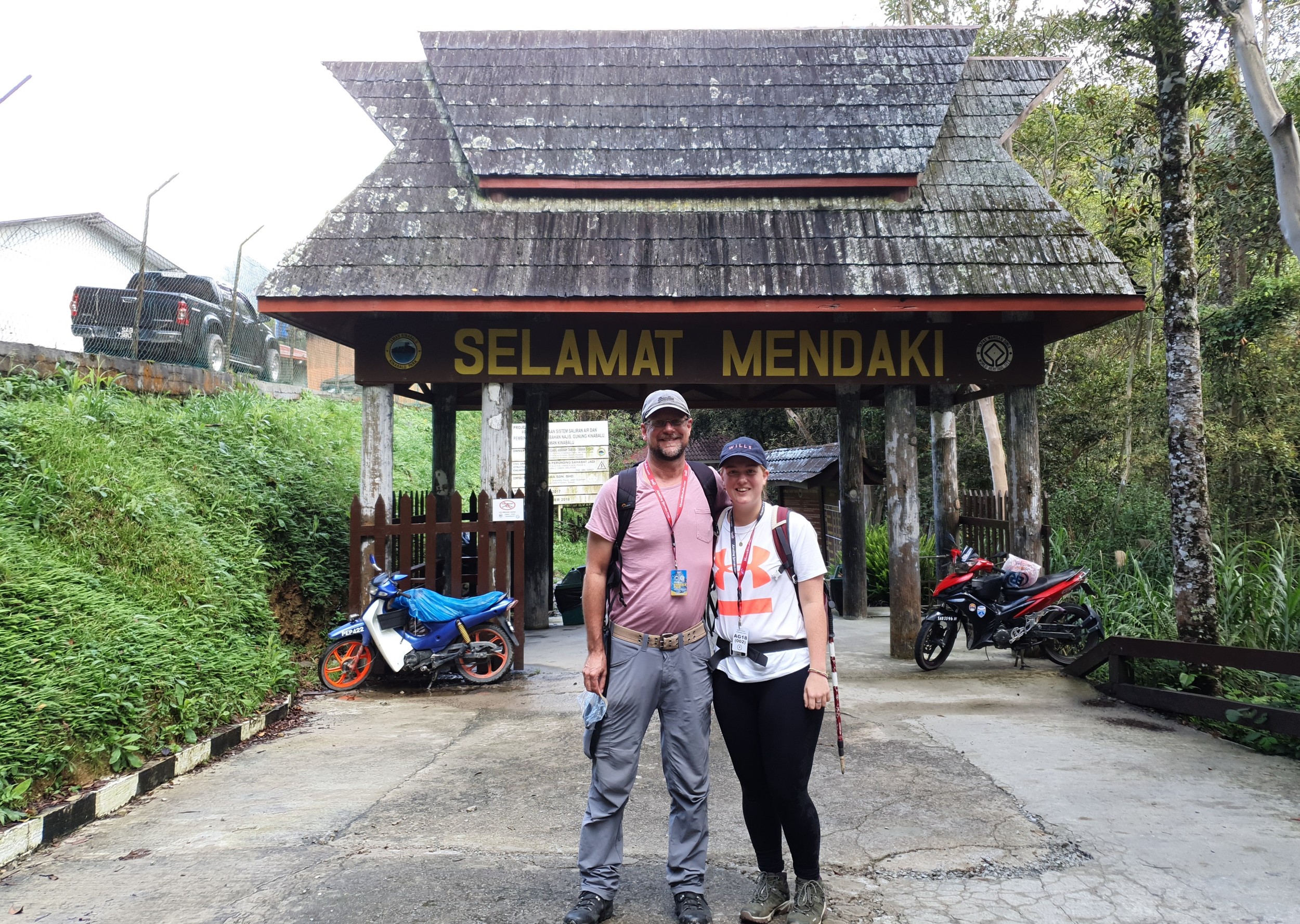
These factors didn’t really cross my mind much for the first few hours as we seemed to make good time. We were certainly travelling at about the steady pace of other groups around us. The route is dotted with picnic stops every 500m or so in elevation and we would rest, drink, have a snack and watch the endemic squirrels which are habituated to the people and know that an easy meal can often be grabbed.




I was in awe of the porters who carry supplies and equipment up to the Laban Ratu lodge. Wirey strength in small bodies, balancing loads of 20-40kg on their backs they travelled with apparent effortless ease up the mountain-side, leaving us in their wake. Our own guide Rony was a man of few words but in broken English did confess to us he makes the trip 2-3 times per week.


As we rose up the lush tropical rainforest gave way to alpine scrub, reminding me of coastal vegetation in WA or SA, low stunted, small-leaved shrubs adapted to harsh conditions. As the day wore on the clouds built – as they do almost every day in this part of the world – obscuring our view of the peak and to the countryside below, shrouding the path and surrounding forest in mist.






The path got steeper and rougher and Eri’s strength was starting to wane, but we arrived at Laban Ratu at 2pm still in good spirits. We bagsied a bed each in the shared bunk-house that was our “reward” for picking the cheapest option! I showered (it was cold) and then we both immediately bunked down to get some rest before dinner.

Dinner was a buffet, a decent spread included in the price of our package. To try to restore some warmth we both indulged in some hot milo which cost us extra but was well worth it! It was humbling to realise that all of the food we were eating and gas used to cook and heat it had all been carried up on the porters’ backs.
We chatted with a super-friendly and very beautiful couple from Hong Kong, Mark and Vivian, now both junior doctors in the NHS working in Southampton. When we said good night, they sloped off to a private room, leaving us wishing we’d forked out the extra too. Back in the dorm, I had one of the least comfortable night’s sleep I have ever had. It was freezing cold, we were nervous of having to wake at 2am, and in the shared dorm there was constant coughing, snoring, spluttering or someone going to the toilet at seemingly every moment of the night. I suppose I got some sleep, but it didn’t feel like much.
By 2am our alarms sounded and we started to get ourselves ready for the push to the top. Although yesterday I had felt lucky to have escaped the worst of altitude sickness, today I woke with a slight queeziness and mild headache that robbed me of any appetite. Knowing the importance of getting some calories in, I forced myself to eat something, and at 3am we met our guide and set off by the light of our head torches.
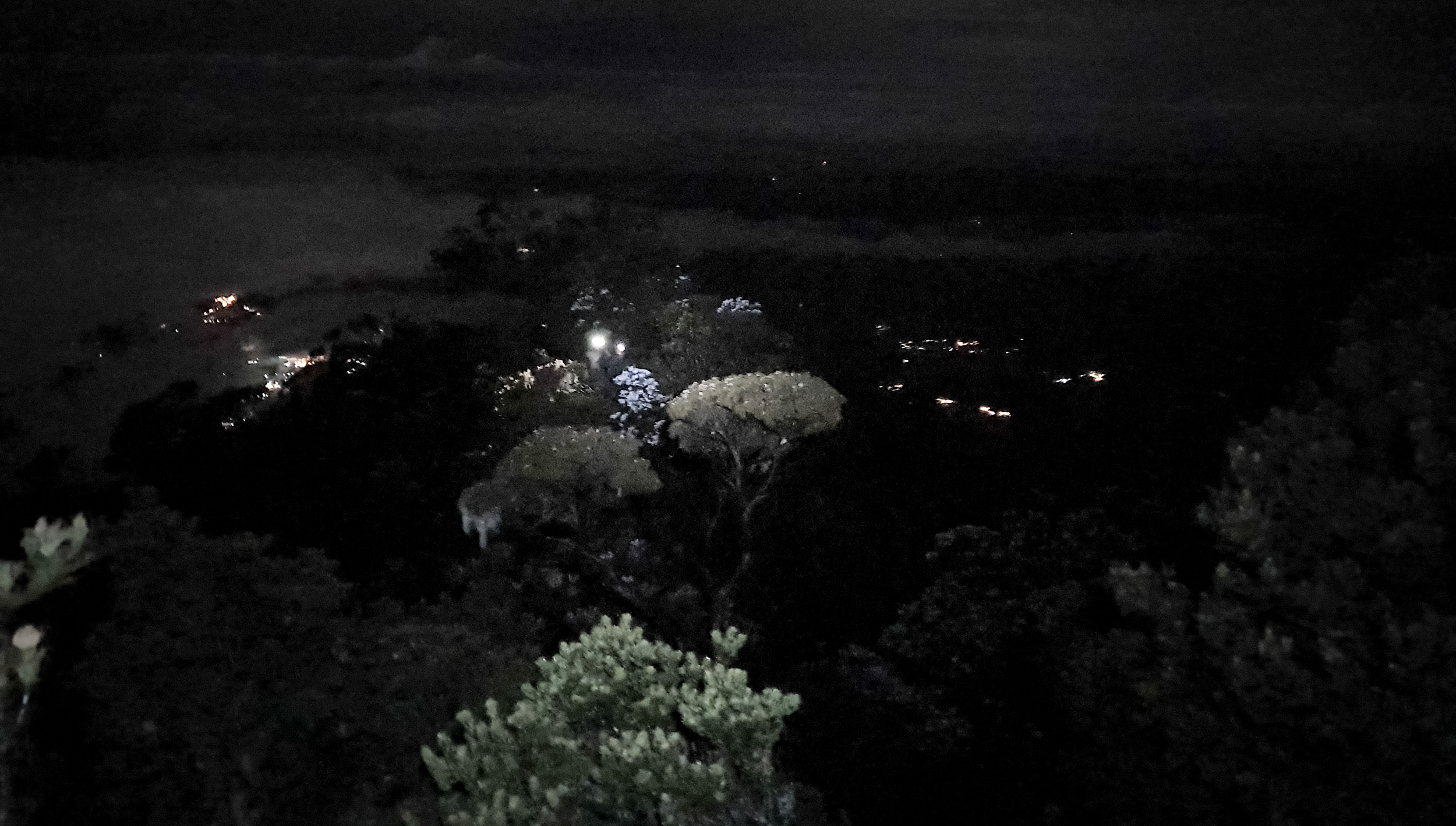
Part two of the walk, to the peak, is “only” 2.7km, but it ascends 800m. Far from being better accustomed to the altitude after our night, I was still feeling weird as we set out, so I struck a deliberately slow but steady pace. The first kilometre has a number of wooden steps and boardwalks that help with the increased gradient of the day two route. Our torches illuminated the path immediately in front of us, but otherwise all we could see was a string of point-lights along the path above where the pace-setters were moving. Looking back the other way we could see the lights of the lodge and the stragglers behind us. Gradually my head cleared and I felt like I’d banished the mild altitude sickness I’d woken with, but even at our reduced pace I could see and hear that Eri was struggling for breath with the altitude. Every fifty metres, or sometimes even more frequently, she had to stop just to get her breath back.
After that first kilometre in which the path ascends 400m we reached the Sayat-Sayat checkpoint, pretty-much at the tree-line, where park staff make note of arrivals and departures. It’s a reminder that although open to tourists, this is not without risk, and in 2001 a 16 year old girl died when she strayed from the path by just a few hundred metres and was lost in poor weather. Beyond the check-point the mountain is just bare granite, and the path is a line marked by a rope that you grip to help pull yourself up. It had rained overnight, and though it was mercifully not raining now, the rock-face was slippery, in places like ice! At one such point Eri took a nasty tumble and badly hurt her knee. We also found that our woollen gloves, soaked from holding the wet rope, were now basically useless as insulation. Our fingers were like icicles and barely able to grip the rope. Eri soldiered on another few hundred metres, but when we had reached 3800m a.s.l., and we were about 2/3 way up the very steepest, trickiest part of the path, Rony beckoned me over: we still had 1km to cover and at our current rate we would not make the summit by dawn. In itself that would not be a disaster, but we also needed to descend the whole mountain afterwards. I made the tough call – we would enjoy the view from here, but not press on. It seemed to me we risked further and worse injury, just for the satisfaction of saying we had done it. The view itself would not change much, and we might as well rest while watching the sunrise then begin the walk down. Eri cried, a combination of the pain from her knee and disappointment at having come so far. Perhaps she felt she’d somehow let me down, but I was able to comfort her that that was never the case. Maybe there was even some relief and release in those tears.

We descended with some difficulty back to Sayat-Sayat by torch-light and then watched as the world was gradually revealed by the rising sun. The view was spectacular – not much different from what we would have seen from Low’s Peak (arguably even better) with an enormous duvet of clouds blanketing the earth. Just above the clouds Laban Ratu nestled on a tiny plateau far below.







As we descended, now it was light, we could actually see the path and the amazing view, and over the course of the next 30min the clouds rolled away, and we really did feel like we were on top of the world. Of course, even without reaching the top, at 3800m we were higher than anywhere between the Himalayas and West Papua.










It took 90mins to descend to the lodge where we rested for 20 minutes had a quick cup of tea before gathered our belongings for the long descent all the way back to the park HQ. One poor guy in the lodge, presumably overwhelmed with altitude sickness, seemed barely to have moved from his position head down on a table. Goodness knows how he was going to make it back down the mountain.
We set out at 7.50, and finally made it back to the Timpohon Gate at about 13:40, getting on for 11 hours since we had embarked this morning.


The drive back to KK from the mountain should have been uneventful, but I was fearful of running out of fuel, so we freewheeled for almost 50km down the mountain. Finally back in Kota Kinabalu I dropped Eri at our hotel, returned the car to the airport and got a cab back to join her. Though our original plan was to explore KK a bit and maybe find a nice place to have some local food, neither of us could face any more walking, or any more rice, so we ordered a pizza via room service and flopped on our oh-so-comfortable beds. The next morning again we baulked at tourist stuff, but did manage to hobble our way down to the beach. I thought Eri was going to pass out at one point, but I found a small kiosk and managed to revive her with some water and an icy-pole.






We arrived back in Adelaide via Singapore and Melbourne. Reflecting on our failure to reach the top we both felt a slight pang of disappointment, but even without recreating the fatigue and discomfort, we still agreed it was the right call to abort when we did. It had been an amazing adventure, and so brilliant to spend some quality alone time, father and daughter, for the first time. Fortunately the long waits for invisible Ground-cuckoos and the super-strenuous walk – probably the toughest physical test Erica has ever undertaken in her 19 years – failed to dampen her enthusiasm for travel and maybe I’ll be able to persuade her to come on another trip: perhaps Gorillas and Shoebills in Uganda beckon…
[1] Erica swears I had my binoculars with me and birded on the way up, but the photographic evidence says otherwise. What kind of a plonker would carry bins in a bag, taking the weight penalty without the optical benefit!

